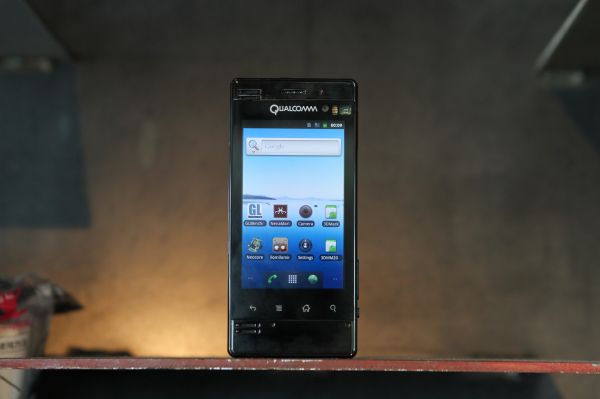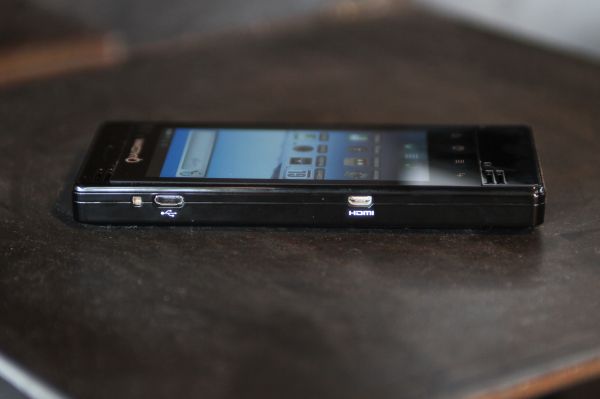Dual Core Snapdragon GPU Performance Explored - 1.5 GHz MSM8660 and Adreno 220 Benchmarks
by Brian Klug on March 30, 2011 4:29 PM EST- Posted in
- Smartphones
- Snapdragon
- Qualcomm
- Adreno
- MSM8660
- MDP
- Mobile
Way back at CES we saw our first glimpse of MSM8x60 and Qualcomm's Snapdragon Mobile Development Platform (MDP) with an MSM8660 SoC inside. Though we couldn't run any benchmarks on it, we got a sneak preview of dual core snapdragon. This year at MWC Qualcomm gave us a considerable amount of hands-on time with the same MDP hardware. We did a bit of testing, and then Qualcomm did something awesome - they let us take an MDP with the MSM8660 inside home with us.
In case you haven't been following, MSM8x60 is Qualcomm's first dual-core SoC. It's two Scorpion cores, an Adreno 220 GPU, and cellular modem all built on the 45 nm process. Like the rest of Qualcomm's lineup, the x in MSM8x60 can either be a 2, denoting GSM, UMTS, and HSPA+ support, or a 6, denoting all the same thing but with CDMA2000 and EVDO. Similarly, 9 will connote LTE support when we get to that point as well. MSM8x60 comes clocked at either 1.2 GHz or a higher 1.5 GHz. The MDP we were given was the higher 1.5 GHz variant. The MSM8x60 is the successor to MSM8x55, which is single core 1 GHz Snapdragon and Adreno 205, also built on 45 nm process.
| Qualcomm Mobile Development Platform (MDP) | |
| SoC | 1.5 GHz 45nm MSM8660 |
| CPU | Dual Core Snapdragon |
| GPU | Adreno 220 |
| RAM | (?) LPDDR2 |
| NAND | 8 GB integrated, microSD slot |
| Cameras | 13 MP Rear Facing with Autofocus and LED Flash, Front Facing (? MP) |
| Display | 3.8" WVGA LCD-TFT with Capacitive Touch |
| Battery | 3.3 Whr removable |
| OS | Android 2.3.2 (Gingerbread) |
It's been a bit busy since we got the MDP home with us, but we've run and re-run tests on the MDP all along and are ready to talk about GPU performance. The MDP we have right now is optimized for evaluating graphics performance, which we'll take a look at in this article. We'll then go into architectural changes between Adreno 200, 205, and 220, and then do the same combo of performance numbers plus architectural deep-dive with the CPU side of things in a future article.
The MDP itself is stark black and completely utilitiarian - it's a glossy, tall, extremely square package, but a smartphone nonetheless. It runs Android 2.3.2 (as an aside, isn't it ironic that prototype devices are running newer builds of Android than most smartphones you can buy retail right now) and has a number of interesting extras. There's a 13 MP rear facing camera with LED flash, front facing camera, 3.8" WVGA display, speakers, microHDMI port, microUSB, and microSD card slot. The MDP's battery is a comparatively tiny 3.3 Whr, but the entire package is totally mobile.
The one we have is again optimized for GPU testing, and sadly lacked cellular connectivity or WiFi, but gets the job done nonetheless.
The MDP's purpose is to act as a pre-commercial handset for software development rather than be something you'd ever carry around. Making reference hardware designed for developers isn't anything new in the SoC space - look no further than OMAP's Blaze platform. Qualcomm started making MDPs with the MSM8655 and sells them through bsquare, who sells them for $995. Though it isn't up yet, both these pages will soon have the MSM8660-based Mobile Development Platform.
One of the more interesting things about the MDP is that because it's a development platform, not a consumer device sold by an OEM though a carrier, it can either have Vsync enabled or disabled. This is the framerate cap we've seen on virtually every other device, which usually is right around 60 Hz. Through adb, we can turn Vsync on or off on the fly, then reboot Android's surface flinger and run tests. Sadly this procedure, while simple on the MDP, doesn't work on any other devices that aren't running Qualcomm's Android builds.
Since all of the devices we've tested thus far have been commercial, they've shipped with Vsync on and thus are limited to around 60 FPS. Thus, more than a few platforms could have had instantaneous bursts during test runs which are clipped to Vsync. To be fair to those, we've run everything on the MDP with Vsync on and off for illustrative purposes.
The MDP we tested was running all out, with maximum clocks and no power management thorottling CPU or GPU clocks down based on usage and load. As a result, testing was performed constantly plugged into a beefy USB AC power adapter. Though these benchmarks show off what MSM8660 is capable of, actual performance in shipping devices will obviously be different depending on UI, power management, and display resolution choices made by Qualcomm's OEM customers, like HTC.



















70 Comments
View All Comments
metafor - Thursday, March 31, 2011 - link
Keep in mind that as you scale to higher resolutions, you won't be clipping the 60fps limit as much.So if Adreno is capable of going higher but isn't due to the fps cap, then it won't be slower at higher resolutions.
This isn't true of Egypt from what it seems though.
Alexstarfire - Thursday, March 31, 2011 - link
I would agree when you're strictly comparing GPUs, but we're almost comparing platforms in here. The problem is that you can't run most things on mobile platforms at any resolution you want. You're stuck with native resolution in just about every case.If you're trying to figure out which GPU is better then you certainly need to take resolution out of the equation. Can't really do that with mobile devices though.
You also have to remember that performance isn't necessarily linear across resolutions, especially if there is an FPS cap.
michael2k - Thursday, March 31, 2011 - link
What? 840x480 is half the iPad's resolution! 1024x768!The iPhone is 960x640, also much higher.
The iPad->iPad 2 difference of 6.4->44.8 or 17.6->57.6 tells us the iPhone 4 should be quite competitive with the dual core Snapdragon; 5.9->42 for Egypt and 50 for GL Pro 2, and at a much higher resolution to boot.
Any phone that uses the Adeno 220 and a higher resolution (like via HDMI out), will see their scores drop in half, while the iPhone should chug along without much difference.
B3an - Thursday, March 31, 2011 - link
How can the iPhone 4 remotely compare? Dont you not mean iPhone 5?Because the Motorola Atrix 4G has about the same screen res (540 x 960) yet it performance more than 2x as well as iPhone 4 in most benches. The Atrix's CPU and GPU are not even as fast as this new Scorpion SoC.
michael2k - Thursday, March 31, 2011 - link
You're right, I meant A5 on the iPhone 5.kade1878 - Saturday, April 2, 2011 - link
So lets compare the iPhone 4 to the Motorola Atrix 4G:iPhone: 960x640 = 614400
Atrix: 960x540 = 518400
So the ratio is ~1.19 or the iPhone 4 has 19% more Pixels than the Atrix.
Now compare that to the Benchmark result:
iPhone: 5.9 fps x 614400 pixels/frame = 3.624.960 pixel/s or ~3.6 MPixel/s
Atrix: 18.7 fps x 518400 pixels/frame = 9.694.080 pixel/s or ~9.7 MPixel/s
flipside101 - Saturday, April 2, 2011 - link
its slightly off topic but does anyone hve a handle on why no one else is using the PowerVR SGX543MP2 . its not apple tech but is it possible that they have an exclusive license ?ta
dagamer34 - Saturday, April 2, 2011 - link
TI and Samsung are the only other major companies besides Apple that usually use PowerVR chips. This year, Samsung stuck an ARM-based GPU into their chip, the Exynos (ARM GPU is the Mali 400) and Ti's OMAP 4430 has so far only been used in the Blackberry Playbook. All smartphone uses of the OMAP 4xxx platform are to be launched in the 2nd half of this year.GnillGnoll - Wednesday, April 6, 2011 - link
I'm sure Intel and Renesas would disagree with your definition of "major companies", among others. And the LG Optimus 3D smartphone (with OMAP4430) will be available by the end of the month.Renesas announced a SoC with SGX543MP2, so it's certainly not Apple exclusive tech.
scofflaw - Wednesday, March 30, 2011 - link
The original MDP8655 which I have has VEE display backlight control which when enabled can really lower the battery drain when running certain apps. Does this new MDP8660 have it as well?